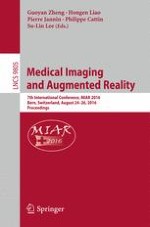2016 | Buch
Medical Imaging and Augmented Reality
7th International Conference, MIAR 2016, Bern, Switzerland, August 24-26, 2016, Proceedings
herausgegeben von: Guoyan Zheng, Hongen Liao, Pierre Jannin, Philippe Cattin, Su-Lin Lee
Verlag: Springer International Publishing
Buchreihe : Lecture Notes in Computer Science
